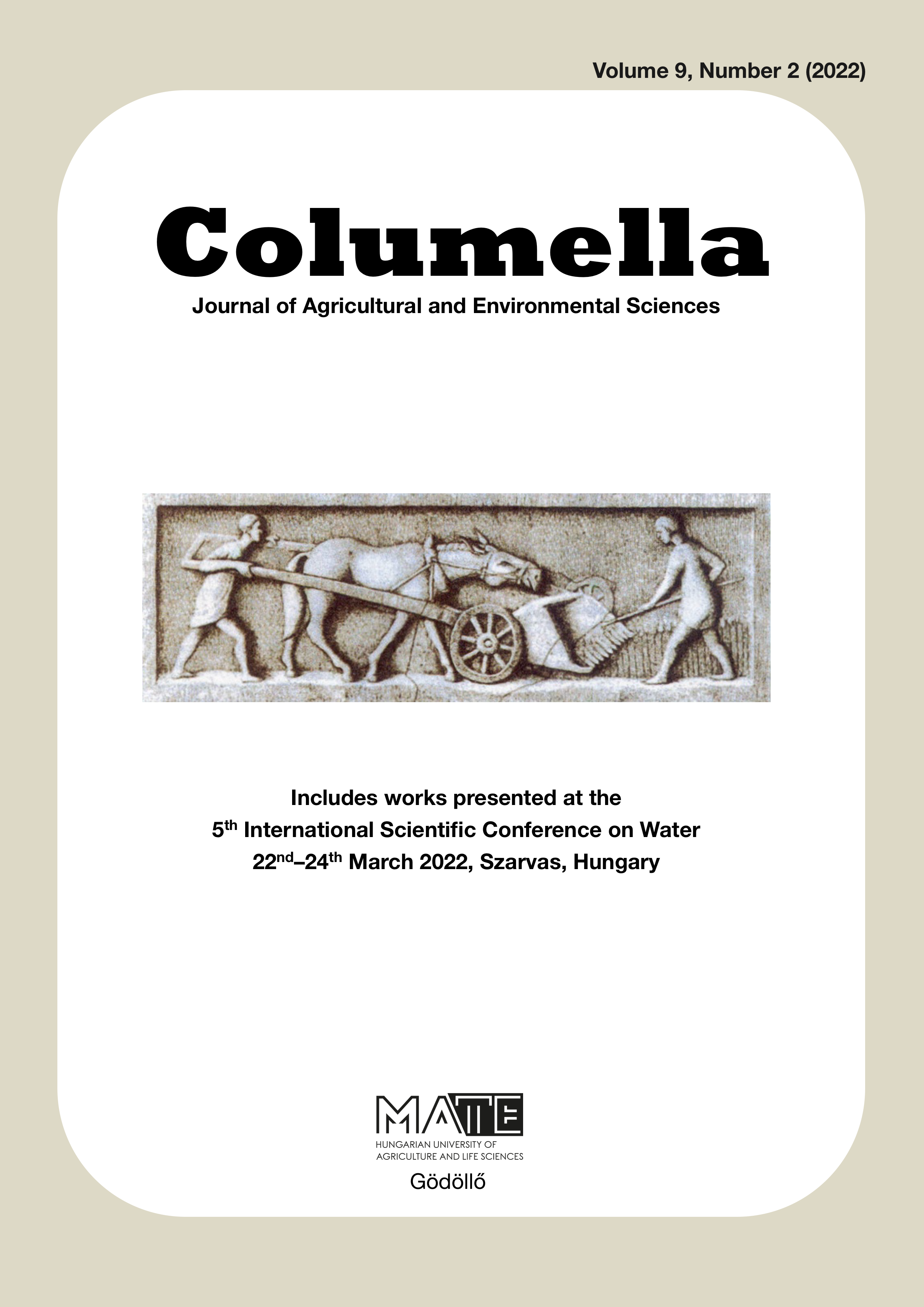Examination of water and salt stress for five different maize hybrids
DOI:
https://doi.org/10.18380/SZIE.COLUM.2022.9.2.155Keywords:
SPAD, LAI, Drought-stress, CornAbstract
In today's climatic conditions, the yield-reducing effects of drought are increasingly being felt. Farmers should take every opportunity to mitigate these effects. Irrigation is the easiest and most effective way to eliminate the damage caused by drought, however, a new promising method has also emerged in hybrid production. The production of drought-tolerant hybrids is a new trend that can easily affect the amount and quality of crops to be harvested in a drought year. In the course of the research, we investigate the drought responses of different hybrids, in different water doses, in an environment closed from external precipitation in several replicates.
References
Antal, J. (Ed.). (2005). Növénytermesztéstan 1., A növénytermesztés alapjai. Budapest: Mezőgazda Kiadó.
Basal, O. (2020). The effects of drought stress on soybean growth, psysiology an quality (Unpublished doctoral dissertation). University of Debrecen, Debrecen.
Birkás, M., & Szieberth, D. (1998). Amit a kukorica termesztésről tudni kell. Budapest: AGROINFORM kiadó.
Chaves, M. M., Maroco, J. P., & Pereira, J. S. (2003). Understanding plant responses to drought — from genes to the whole plant. Functional Plant Biology 30(3), 239. doi: https://doi.org/10.1071/fp02076
Chen, C., Payne, W. A., Smiley, R. W., & Stoltz, M. A. (2003). Yield and Water-Use Efficiency of Eight Wheat Cultivars Planted on Seven Dates in Northeastern Oregon. Agronomy Journal 95(4), 836-843. doi: https://doi.org/10.2134/agronj2003.8360
Cong, X., Pang, G., Xu, Z., & Wang, R. (2021). Physiological responses of winter wheat (Triticum aestivum l.) to alternate irrigation with fresh and brackish water. Applied Ecology and Environmental Research 19(4), 3137-3152. doi: http://dx.doi.org/10.15666/aeer/1904_31373152
Füleky, G. (1999). Tápanyag-gazdálkodás. Budapest: Mezőgazda Kiadó.
Futó, Z. (2003). A levélterület hatása a kukorica terméseredményére trágyázási kísérletben. Növénytermelés 52(3-4), 317-328.
Futó, Z., & Sárvári, M. (2015). A kukoricatermesztés technológiájának fejlesztési lehetőségei. Gödöllő: Szent István Egyetemi kiadó.
Gyulai, B., & Sebestyén, E. (2011). Adalékok a kukorica trágyázásához. Agrárágazat 12(4), 40-42.
Hegedűs, I. (1984). Tavaszi talajművelési módok vizsgálata kukorica monokultúrában. Növénytermelés 33(2), 171-177.
Jiang, M.-Y., & Zhang, J.-H. (2004). Abscisic acid and antioxidant defense in plant cells. Acta Botanica Sinica – English Edition 46(1), 1-9.
Kaur, L., & Zhawar, V. K. (2015). Phenolic parameters under exogenous ABA, water stress, salt stress in two wheat cultivars varying in drought tolerance. Indian Journal of Plant Physiology 20(2), 151-156. doi: https://doi.org/10.1007/s40502-015-0156-5
Kovács, J. (Ed.). (1981). Növénytermesztési praktikum. Budapest: Mezőgazdasági Kiadó.
Liu, X., & Vance Baird, W. (2004). Identification of a novel gene, HAABRC5, from Helianthus annuus (Asteraceae) that is upregulated in response to drought, salinity, and abscisic acid. American Journal of Botany 91(2), 184-191. doi: https://doi.org/10.3732/ajb.91.2.184
Menyhért, Z. (Ed.). (1979). Kukoricáról a termelőknek. Budapest: Mezőgazdasági Kiadó. Nyíri, L. (Ed.). (1997). Az aszálykárok mérséklése. Budapest: Mezőgazda Kiadó.
Pepó, P. (2011). Növénynemesítés. Az agrármérnöki Msc szak tananyagfejlesztése. Debrecen.
Petrasovits, I., & Balogh, J. (1969). Növénytermesztés és vízgazdálkodás. Budapest: Mezőgazdasági Kiadó.
Radics, L. (Ed.). (2003). Szántóföldi növénytermesztés. Budapest: Szaktudás Kiadó Ház Rt. Shao, H., Liang, Z., Shao, M., & Wang, B. (2005). Changes of some physiological and
biochemical indices for soil water deficits among 10 wheat genotypes at seedling stage. Colloids Surf. B: Biointerfaces 42(2), 107-113.
Szász, G., & Tőkei, L. (Eds.). (1997). Meteorológia mezőgazdáknak, kertészeknek, erdészeknek. Budapest: Mezőgazda Kiadó.
Zhu, J., Shi, H., ha Lee, B., Damsz, B., Cheng, S., Stirm, V., . . . Bressan, R. A. (2004). An Arabidopsis homeodomain transcription factor gene, HOS9, mediates cold tolerance through a CBF- independent pathway. Proceedings of the National Academy of Sciences 101(26), 9873-9878. doi: https://doi.org/10.1073/pnas.0403166101
Downloads
Published
Issue
Section
License
Copyright (c) 2022 Ádám Komlósi, Dr. Futó Zoltán , Bencze Gábor

This work is licensed under a Creative Commons Attribution-NonCommercial-NoDerivatives 4.0 International License.






